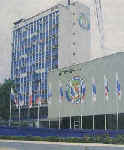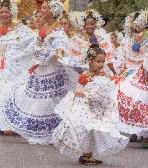Branches:
Executive--president (chief of state), two vice
presidents. (Note: In May 2009, Panama
elected only one vice president; the second vice presidential
slot has been abolished starting with the 2009 electoral cycle.)
Legislative--National Assembly (unicameral,
78 members, reduced
to 74 members for May 2009 elections). Judicial--Supreme
Court.
Subdivisions:
Nine provinces and five (Indigenous) territories (comarcas).
Political parties:
Panamenista Party
(formerly the Arnulfista Party (PA); Democratic Change (CD); National
Liberal Republican Movement (MOLIRENA); Democratic Revolutionary Party (PRD);
Patriotic Union (UP).
Suffrage:
Universal at 18.
ECONOMY
GDP (2008 estimate): $23.42 billion.
Annual growth rate (2006) 8.1 percent;
(2007) 11.5 percent; (2008) 9.2 percent.
Per capita GDP (2008 estimate,
purchasing power parity): $11,900.
Natural resources: Timber,
copper, gold.
Services (77.6 percent of GDP): Finance,
insurance, health and medical, transportation, telecommunications, the
Canal and maritime services, tourism, Colon Free Zone, public
administration, and general
commerce.
Agriculture and fisheries (6.2 percent of GDP):
Products--bananas and other fruit, corn, sugar, rice, coffee, shrimp,
timber, vegetables, livestock.
Industry/Manufacturing
(16.1 percent of GDP):
Types--food and
drink processing, petroleum products,
chemicals, paper and paper products, printing, mining, refined sugar,
clothing, furniture, construction.
Trade (2008): Exports (goods)--$10.37
billion:
bananas, petroleum products, shrimp, sugar, coffee, and clothing.
Exports to U.S.-- $377 million (3.9 per cent of total). Imports
(goods) -- $15.18 billion: capital goods, crude oil, foodstuffs, chemicals,
other consumer and intermediate goods. Imports
(goods) from U.S.--$4.9
billion (32 per cent of total).
PEOPLE
Panamanians' culture, customs, and language
are predominantly Caribbean Spanish. The majority
of the population is ethnically mestizo (mixed Spanish and
indigenous or mixed Spanish, Chinese, and West Indian. Spanish is the official and dominant
language; English is a common second language spoken by the West Indians
and by many businesspeople and professionals. More than half the population
lives in the Panama City-Colon metropolitan corridor.
Panama is rich in folklore and popular
traditions. Brightly colored national dress is worn during local festivals
and the pre-Lenten carnival season, especially for traditional folk dances
like the tamborito. Lively salsa--a mixture of Latin American popular
music, rhythm and blues, jazz, and rock--is a Panamanian specialty, and
Ruben Blades is its best-known performer (and Minister of Tourism
2004-2009). Indigenous influences dominate
handicrafts such as the famous Kuna textile molas. Artist Roberto Lewis'
Presidential Palace murals and his restoration work and ceiling in the
National Theater are well known and widely admired.





